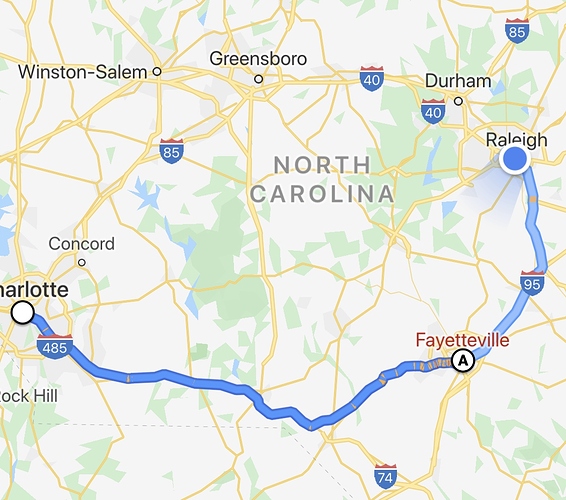Another issue for Montreal in the 90s was the strength of the US Dollar versus the Canadian dollar. That has changed significantly over the last 15 or so years and would be a negligible issue.
The Canadian “peso” is back at a 30% discount, so still not good for them. 10 years ago the dollars were about even. Its great when we go north, not so good when my wife’s family comes south.
This is more of a cool chart that I’ve been dying to have an excuse to show off than a strictly MLB-related thing, but I think I can find a hook to hang it on here.
When assessing states like North Carolina as possible locations for pro sports franchises, we typically look at population figures, which makes perfect sense, but it might be more helpful to look at the size of a state’s economy–sports teams are out to make money, and it’s easier to make money if the fans in your market have a lot of it.
There’s been a tremendous amount of economic growth in the Charlotte and Raleigh-Durham markets, so if you live in those areas you might think that North Carolina has been moving up the league tables in terms of state-level GDP. But it turns out that North Carolina is currently 12th in the U.S. in GDP–the exact same position that it held in 1980! South Carolina, meanwhile, has moved up a few spots since then. (Seriously, the chart in this story is beautiful.)
This ties in nicely with the “Two North Carolinas” series that the News & Observer has been running this week. To oversimplify a little, economic declines in rural North Carolina have largely cancelled out growth in urban areas. In fact, North Carolina is actually down three places from where it was before the Great Recession. And, sure, the urban areas are going to be source of most of the revenue for a pro sports team, but for MLB in particular, those outlying areas still matter. For quite a few MLB teams, state borders also mark the boundary lines of their natural fan bases.
Looking at this from a baseball-specific perspective, a couple of things jump out at me:
Aside from New Jersey, which is served by the New York and Philadelphia teams, North Carolina is the biggest state by GDP without an MLB team. (Virginia, which is partly served by Washington, D.C. is next, and then it’s a long way down to Indiana.) But the catch is that unlike in states like Wisconsin, Michigan, Colorado, and Minnesota, it’s not realistic to think that one team could dominate the whole state. You’d either get the Charlotte region or the Raleigh-Durham region, but not both.
The two smallest states by population with MLB teams are Colorado and Minnesota (21st and 22nd by population; Colorado just squeaked past Minnesota’s population this year.) But by GDP they’re 16th and 17th, respectively, so you could see why those would be attractive markets. (Maryland also punches above its weight economically.)
Looking at other possible expansion markets, Oregon is growing rapidly, but would still be the smallest state (by population or economy) with an MLB team, although they might be able to poach away some fans just across the Oregon-Washington border. (Consistent with the headline of this story, the future looks rosy for the Seattle Mariners.) Tennessee’s economy is bigger than Oregon’s and would be perfectly big enough. Putting an MLB team in Nevada, on the other hand, looks like quite the risky gamble–its economy is way smaller than Oregon’s, and has actually gone down in the table since the Great Recession.
You can see why MLB would be very, very eager to keep two teams in Florida, which has climbed up to No. 4.
But, seriously, I love this fascinating chart and am glad to finally have an excuse to show it off.
Retail follows rooftops, it only makes sense that pro sports follows wealth.
Your points seem echoed at the micro level in the lack of a real high-end hotel downtown.
Nice summery, great information, good points.
Speaking of which, GDP numbers by counties were released. Wake-Durham is at around $105 billion. That’s about what Tarrant County (Ft. Worth) is.
Oh my goodness look at all this amazing data! I am swimming in county-level GDP data the way Scrooge McDuck swims in his vault of money! Thank you thank you thank you thank you!!

This is fascinating. Mecklenburg County by itself is over $97 billion. So Mecklenburg + York County, S.C. is an ever-so-slightly bigger economy than Wake-Durham. I would not have expected that. (And obviously Tarrant Co. is less than half the size of Dallas County, which is the big fish in that market.)
San Diego County is really fascinating to me from a baseball perspective, because the Padres have a really tightly circumscribed market. SDC is bordered by the Pacific Ocean to the west, Mexico to the south, desert to the east, and Orange County (where the Padres run a distant third place to the Angels and the Dodgers) to the north, so their market really is that one county. But in terms of economy, San Diego County is more than twice the size of Wake and Durham combined, and larger than even a very optimistic estimate of the size of the market a Raleigh team might be able to dominate.
Well speaking purely on baseball terms, San Diego seems the wrong tack. There are over 3 million in the San Diego area. I’d look at the Cincinnati’s and Nashville’s to get a clearer picture. And yes, growth rate as well.
Oh, yeah, I wasn’t thinking of San Diego as a comp to Raleigh, or really any place other than itself. What I find interesting about San Diego is that the boundary lines of where the fan base begins and end are so uniquely definite. Most fan bases kind of diffuse over a wide area, so that as you get further and further away from the urban core they start to gradually thin out, so it’s tough to say exactly where a natural market begins and ends in some cases. Raleigh would be more like Cincinnati in that regard, absolutely.
Also, these numbers get reiterate, even more so than the population numbers, how crucial it would be for any MLB team in North Carolina to command loyalty in the Greensboro and Winston-Salem markets. Would a Charlotte franchise dominate that market? Would a Raleigh franchise dominate that market? I think in both cases the answer would probably be yes, but it just goes to once again show that the success of a Raleigh team would depend on winning over fans in places that are quite far away from the city.
I think Fayetteville would be a crucial market to win. Probably most of the East, but them in particular.
Greensboro and east, it’s an easy drive to the Triangle. WInston may lean more toward Charlotte.
I remember when the triad was trying to get the Twins to move. I always wonder if that would have ever worked out if it came to fruition.
Oh, yeah, that would be hugely important. And that actually leads to another thing I noticed when I started looking at TV market sizes. As some folks have pointed out, in raw population terms, Raleigh’s TV market is ever-so-slightly smaller than Charlotte’s, but the difference is trivial. But, significantly, Raleigh’s market includes Fayetteville, which is a perfectly winnable area for a Charlotte franchise. And there’s no place where the inverse is true, no part of Charlotte’s TV market that looks winnable for a Raleigh franchise.
By the way, before a started looking into it, I assumed that Greensboro/Winston-Salem was the third-largest TV market in the Carolinas. But I was surprised to learn that the third-largest market is actually Greenville-Sparanburg-Asheville. Some of that is solidly Braves country, but a lot of it would be very winnable for a Charlotte franchise–but not at all realistic for a Raleigh franchise. Next comes Greensboro/Winston-Salem, which is pretty neutral turf. Then comes Columbia, which would be a natural part of Charlotte’ market but not Raleigh’s. Charleston is safely Braves country, and the remaining markets (Myrtle Beach, Greenville and Wilmington) are all pretty tiny.
Again, I don’t know how much of this matters since it’s all ultimately going to come down to ownership groups and stadium subsidies, but looking at where the televisions are, I can definitely see why MLB is so keen on Charlotte.
Charlotte’s goes to Boone. There is nothing small about Charlotte’s tv market area.
Yeah, now that I look at it more closely, they’re pretty comparable in physical size. (In the map I’m looking at, RDU, G/W-S and Norfolk are all the same shade of yellow, which makes it a pain to tell what’s what.) I’ve edited my post accordingly. Thanks.
But the Charlotte market stretches a lot to the west, which is even further away from Raleigh, whereas the Raleigh market has this is big chunk of population in Fayetteville that’s not that much further away from Charlotte than it is from Raleigh.
Where is this TV market map? Looking for something in the above posts but only see GDP link.
Fayetteville is not close to Charlotte. Its like 150 miles of bad roads away from each other.
Fayetteville is 2 hours 45 minutes to Charlotte vs an hour to Raleigh based on Google with current traffic conditions. Not significant but definitely not close to the same. A 5 hour round trip isn’t a drop in the bucket but an hour there and back is easy.
Sometimes visuals are better:
No Interstate from Fay to CLT, nor even a direct highway between the two. Trust me, not a desirable trip.
Winston Salem is within Charlotte’s sphere. I think Spartanburg, Greenville, Hendersonville and Asheville are all extremely Charlotte centric.
Fayetteville to Charlotte is rough. When I lived in Charlotte, Fayetteville wasn’t even on our radar.
